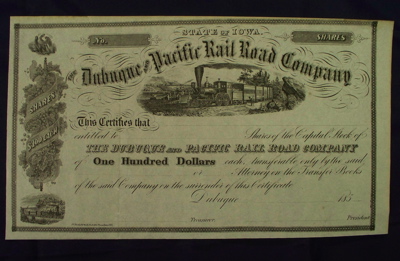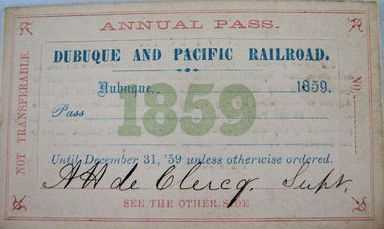Encyclopedia Dubuque
"Encyclopedia Dubuque is the online authority for all things Dubuque, written by the people who know the city best.”
Marshall Cohen—researcher and producer, CNN
Affiliated with the Local History Network of the State Historical Society of Iowa, and the Iowa Museum Association.
DUBUQUE AND PACIFIC RAILROAD: Difference between revisions
No edit summary |
No edit summary |
||
| Line 13: | Line 13: | ||
of the road." — (Express and Herald., November, 1855.) (5) | of the road." — (Express and Herald., November, 1855.) (5) | ||
Colonel Mason resigned as the chief engineer on July 31, 1855. Immediately, however, the "paper railroad" made a contract with Mason, Bishop and Company, headed by Colonel Bishop, to construct a railroad as far west as Dyersville. The first shovel of earth was turned for the project by General Wallace on October 1, 1855. (6) On September 10, 1856 the first locomotive, the Dubuque, was ferried across the [[MISSISSIPPI RIVER]]. | Colonel Mason resigned as the chief engineer on July 31, 1855. Immediately, however, the "paper railroad" made a contract with Mason, Bishop and Company, headed by Colonel Bishop, to construct a railroad as far west as Dyersville. The first shovel of earth was turned for the project by General Wallace on October 1, 1855. (6) On September 10, 1856 the first locomotive, the Dubuque, was ferried across the [[MISSISSIPPI RIVER]]. | ||
The railroad continued to experience great financial difficulties. If Congress had not passed the Iowa Railway Land Grant Act on May 15, 1856 the project might not have survived the year. (7) | |||
It was not until May 1857 that the railroad reached Dyersville. That train, filled with celebrating people, was pulled by "The Jesse P. Farley," the second engine ferried into Iowa. Since the line was not ballasted, the engine jumped the tracks three times. The trip from Dubuque took three hours. Construction was extended to Earlville until work was stopped because of poor credit, lack of a western terminus, and the [[PANIC OF 1857]]. It was also at this time that Senator Wallace, a Democrat, was beginning to lose his legislative power with the rise of the Republican Party. | It was not until May 1857 that the railroad reached Dyersville. That train, filled with celebrating people, was pulled by "The Jesse P. Farley," the second engine ferried into Iowa. Since the line was not ballasted, the engine jumped the tracks three times. The trip from Dubuque took three hours. Construction was extended to Earlville until work was stopped because of poor credit, lack of a western terminus, and the [[PANIC OF 1857]]. It was also at this time that Senator Wallace, a Democrat, was beginning to lose his legislative power with the rise of the Republican Party. | ||
In the summer of 1859, construction resumed under John Edgar Thompson, builder of the Pennsylvania Railroad. The line reached Independence in December and by March 1860 the western border of Buchanan County--about seventy-eight miles. ( | In the summer of 1859, construction resumed under John Edgar Thompson, builder of the Pennsylvania Railroad. The line reached Independence in December and by March 1860 the western border of Buchanan County--about seventy-eight miles. (8) Holding many of the bonds in default, Morris Jesup, the brother of one of the railroad's founders, forced the railroad into receivership. At the time this occurred, the railroad held 1,162,373 acres--its share of an 1856 land grant. (9) | ||
The was reorganized as the [[DUBUQUE AND SIOUX CITY RAILROAD]]. | The was reorganized as the [[DUBUQUE AND SIOUX CITY RAILROAD]]. | ||
[[Image:dubpacpass.jpg|left|thumb|250px|Annual pass.]]Dubuque & Pacific Railroad Company currency was issued. Notes were signed by James M. McKinlay, secretary in 1858. His signature is also found in the same capacity on the Dubuque and Sioux City Railroad notes issued in 1861. Platt Smith, vice president, was the other signer. ( | [[Image:dubpacpass.jpg|left|thumb|250px|Annual pass.]]Dubuque & Pacific Railroad Company currency was issued. Notes were signed by James M. McKinlay, secretary in 1858. His signature is also found in the same capacity on the Dubuque and Sioux City Railroad notes issued in 1861. Platt Smith, vice president, was the other signer. (10) | ||
--- | --- | ||
| Line 39: | Line 41: | ||
6. "An Illinois Central Photo Album Website," Online: http://www.tdf23.info/html/Railroads/DubuqueAndSiouxCityRailroad.htm | 6. "An Illinois Central Photo Album Website," Online: http://www.tdf23.info/html/Railroads/DubuqueAndSiouxCityRailroad.htm | ||
7. Ibid. | 7. "Iowa and Illinois Central." | ||
8. Ibid. | |||
9. Sage, Leland. '''A History of Iowa'''. Ames: The Iowa State University Press, 1974, p. 114 | |||
10. Oakes, Dean G. '''Iowa: Obsolete Notes and Scrip''' Society of Paper Money Collectors, 1982 | |||
Revision as of 21:22, 17 October 2014
DUBUQUE AND PACIFIC RAILROAD COMPANY. In 1851 Iowa's senators, George Wallace. JONES and Augustus Dodge proved instrumental in getting the Illinois Central to extend its line from Galena, Illinois to Dunleith (East Dubuque), Illinois. With that assured, Jones, Platt SMITH, Caleb H. BOOTH, Jesse P. FARLEY, Edward Slossan, Judge John J. Dyer, and banker Frederick Jesup formed the Dubuque and Pacific Rail Road which was chartered on April 28, 1853. (1) At the time of its organization, there was not even one mile of railroad constructed in Iowa. Farley was elected the president and Colonel Boswell B. Mason, chief engineer of the Illinois Central, was made the engineer in chief of the new line. (2) Platt Smith served as the company attorney, Jesup was the treasurer, and Senator Jones was the board chairman.
Several Iowa railroads stood to benefit from federal land-grant legislation passed in 1856. The legislation made about four million acres of land, 10% of the state's total, to railroads in alternate square-mile sections six miles deep on either side of the railroads right-of-way. The railroad could do anything they wanted to with the property. It could be immediately sold or kept to sell to settlers after the price had been driven up. The important condition to this "gift" was, however, that the land could not be claimed by the railroad until tracks actually reached the sections to be claimed. Land grants were of no use for the immediate construction of the railroad. Construction funds had to be raised by the sale of stock and bonds. (3)
Financial problems delayed the beginning of construction of the line. People of Dubuque County subscribed to approximately $250,000 in stock, but bonds were sold for as little as fifty cents on the dollar and land and other collateral were accepted in the place of cash. In 1855 all that had been accomplished was a surveyed route several miles west of Dubuque. (4)
The city and county of Dubuque have negotiated a loan of
$400,000 by Marie and Kanz, of New York, and F. S. Jesup & Co.,
of Dubuque. The loan was made to pay the subscriptions of the
city and county to the Dubuque & Pacific railroad. The coupons
are payable in Berlin, Prussia, and the bonds bear 8 per cent
interest. They are guaranteed by an equal amount of the stock
of the road." — (Express and Herald., November, 1855.) (5)
Colonel Mason resigned as the chief engineer on July 31, 1855. Immediately, however, the "paper railroad" made a contract with Mason, Bishop and Company, headed by Colonel Bishop, to construct a railroad as far west as Dyersville. The first shovel of earth was turned for the project by General Wallace on October 1, 1855. (6) On September 10, 1856 the first locomotive, the Dubuque, was ferried across the MISSISSIPPI RIVER.
The railroad continued to experience great financial difficulties. If Congress had not passed the Iowa Railway Land Grant Act on May 15, 1856 the project might not have survived the year. (7)
It was not until May 1857 that the railroad reached Dyersville. That train, filled with celebrating people, was pulled by "The Jesse P. Farley," the second engine ferried into Iowa. Since the line was not ballasted, the engine jumped the tracks three times. The trip from Dubuque took three hours. Construction was extended to Earlville until work was stopped because of poor credit, lack of a western terminus, and the PANIC OF 1857. It was also at this time that Senator Wallace, a Democrat, was beginning to lose his legislative power with the rise of the Republican Party.
In the summer of 1859, construction resumed under John Edgar Thompson, builder of the Pennsylvania Railroad. The line reached Independence in December and by March 1860 the western border of Buchanan County--about seventy-eight miles. (8) Holding many of the bonds in default, Morris Jesup, the brother of one of the railroad's founders, forced the railroad into receivership. At the time this occurred, the railroad held 1,162,373 acres--its share of an 1856 land grant. (9)
The was reorganized as the DUBUQUE AND SIOUX CITY RAILROAD.
Dubuque & Pacific Railroad Company currency was issued. Notes were signed by James M. McKinlay, secretary in 1858. His signature is also found in the same capacity on the Dubuque and Sioux City Railroad notes issued in 1861. Platt Smith, vice president, was the other signer. (10)
---
Source:
1. Silag, Bill. "The Dubuque and Pacific Railroad," Iowa Heritage Illustrated, Summer and Fall 2002, p.116
2. Ibid.
3. Ibid.
4. "Iowa and the Illinois Central," Illinois Central Magazine. November 1927, p. 2
5. Oldt, Franklin T., History of Dubuque County, Iowa. Chicago: Western Historical Association, 1880. http://www.ebooksread.com/authors-eng/franklin-t-oldt/history-of-dubuque-county-iowa-being-a-general-survey-of-dubuque-county-histor-tdl/page-11-history-of-dubuque-county-iowa-being-a-general-survey-of-dubuque-county-histor-tdl.shtml
6. "An Illinois Central Photo Album Website," Online: http://www.tdf23.info/html/Railroads/DubuqueAndSiouxCityRailroad.htm
7. "Iowa and Illinois Central."
8. Ibid.
9. Sage, Leland. A History of Iowa. Ames: The Iowa State University Press, 1974, p. 114
10. Oakes, Dean G. Iowa: Obsolete Notes and Scrip Society of Paper Money Collectors, 1982
Donovan, Frank P. Jr. Iowa Railroads Iowa City: University of Iowa Press, p. 103-104



